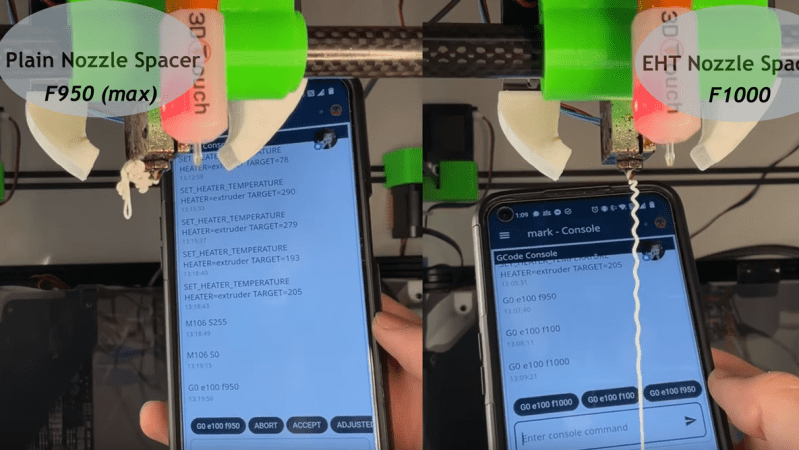The host of problems to deal with when you’re feeling the need for FDM speed are many and varied, but high on the list is figuring out how to melt filament fast enough to accommodate high flow rates. Plus, the filament must be melted completely; a melty outside and a crunchy inside might be good for snacks, but not for 3D printing. Luckily, budget-minded hobbyists can build a drop-in booster to increase volumetric flow using only basic tools and materials.
[aamott]’s booster, which started life as a copper screw, is designed to replace the standard spacer in an extruder, with a bore that narrows as the filament gets closer to the nozzle to ensure that the core of the filament melts completely. Rather than a lathe, [aamott]’s main tool is a drill press, which he used to drill a 0.7 mm bore through the screw using a PCB drill bit. The hole was reamed out with a 10° CNC engraving bit, generating the required taper. After cutting off the head of the screw and cleaning up the faces, he cut radial slots into the body of the booster by threading the blade of a jeweler’s saw into the bore. The result was a bore wide enough to accept the filament on one end, narrowing to a (roughly) cross-shaped profile at the other.
Stacked up with a couple of knock-off Bondtech CHT nozzles, the effect of the booster was impressive — a 50% increase in flow rate. It’s not bad for a prototype made with simple tools, and it looks a little easier to build than [Stefan]’s take on the same idea.
















Whats wrong with the Volcano CHT nozzles? This is basically, what this contraption tries to replicate, no?
https://www.bondtech.se/product/bondtech-cht-volcano-coated-brass-nozzle/
Available as clone from Ali for cheap…
Probably nothing wrong with the Volcano nozzles or knockoffs, but posting “I bought a thing and am using it for the intended purpose” (even off of Ali) on Hackaday is a good way to see Not A Hack rage
because bondtech are Expensive and don’t have a great reputation amongst some 3d’rs, so some people build their own. The newer hotends that are coming online on newer machines just don’t bother with all that, they have a much larger melt zone and a ceramic heater that heats the zone quicker and more efficiently.
I believe you are thinking of Slice, not Bondtech.
Creator here :) Two main reasons:
1. In my setup the booster it’s 50% faster than the clone volcano CHT nozzles (I bought some for testing, but they were basically the same as the spacer and CHT) but it’s still cheaper than the Bondtech.
2. The Bondtech volcano nozzle geometry doesn’t improve flow indefinitely. If you took a supervolcano Bondtech CHT nozzle (imagining they managed to manufacture one) it would be far less impressive than a volcano CHT because filament hands against the CHT face.
This design isn’t meant to replace, but to stack with a CHT, though it still functions better than a clone volcano CHT. It could be made longer with a more gradual slope. Imagine an LSD hotend with this and a Bondtech volcano CHT!
I’m considering spending on a Bondtech Volcano CHT to get more real numbers.
Ah! Makes sense.
Didnt want to nag, was just curious as it looked like you DIY’d a part which was already available for like 1.5 bucks…
Looking forward to what you get in terms of comaprison-Numbers :)
Anyone else bothered by the filament curling on the right hand image? This means you either have a partial clog, or the holes aren’t straight. Probably not great for printing.
If you watch the video you’ll see timing and failure rate is mentioned at a point. The numbers are pre-failure.